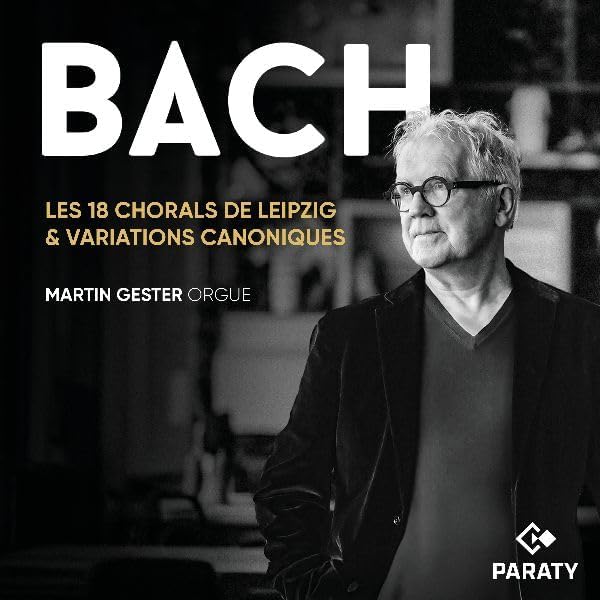Martin Gester organ
109:18 (2 CDs in a card triptych)
Paraty 2025005
This admirable recording was made in October 2024 on an organ built in 2023 within a surviving 18th-century case at St Loup in Namur. The aim was to recreate within the existing rather French-style case an instrument that reflected rather the sound of more central Germany in the mid-18th century. So, unlike the recordings on surviving instruments from the late 17th and early 18th centuries in the north German style made in the 1950s and 60s by organists like Helmut Walcha which have so coloured the way in which Bach’s organ music has been received, here is a recording of two of the great summary collections of Bach’s later years played on the kind of instrument with which Bach would have been more familiar rather than the more severely north German/Dutch instruments by Schnitger with which composers like Buxtehude would have played.
The organ chosen for this recording is by Dominique Thomas, the builders of the substantial 2008 organ in the Temple du Bouclier in Strasbourg, with which Martin Gester is clearly familiar, and there is a wealth of information on the Namur organ – though alas no detailed registration scheme piece by piece. The organ is pitched at Chörton (A465), and tuned in a modified Neidhardt 1724 temperament.
Accompanying Gester’s rhythmically fluid playing, perhaps appreciated best in Allein Gott in der Hoh sei Herr BWV 663 with the cantus firmus in the Soprano (2.1), is a great variety of registration. Ornamented chorales in the right hand are often played on a Sesquialtera or Cornet, sometimes on a reed, and occasionally on an 8’ Principal, as in BWV 959. In An Wasserflüssen Babylon (BWV 653) the Chorale is played in the style of a Chromhorne en Taille. There is liberal use of a tremulant, even with an 8’ Principal, as in the first verse of O Lamm Gottes, unschuldig (BWV 656); I was unprepared for the second verse to be played on the Vox Humana complete with tremulant! This substantial prelude, lasting over 8 minutes, is one of Bach’s most astonishing compositions. When the chorale is given to the Pedal, reeds at several pitches are employed and a pedal bass at 8’pitch – there are no less than four 8’ flue ranks on the pedal organ – is used effectively in a number of the trio movements, like BWV 664, the trio on Allein Gott in der Hoh sei Ehr (2.3), as well as in BWV 663. For Gester’s notes, you need to consult his detailed blog, which will lead you to his reflections on the desert island quality of this miscellaneous collection (so unlike other collections like the well-planned but incomplete Orgelbüchlein) as well as the full texts of the chorales on which the preludes are based, which is highly illuminating for his interpretations.
For the larger Organo Pleno registrations, the instrument provides a variety of options, and Gester does not hesitate to use manual 16’ ranks. In the trio on Nun Komm’, der Heiden Heiland (BWV 661), the ornamented chorale is accompanied by a bicinium of bass parts in close imitation not unlike some of the duets in cantatas for a bass voice and basso continuo, and here the manual left hand betrays traces of a cantata adaptation with its viola da gamba-like chords at cadences that link it stylistically to the Schübler Chorales.
The obvious comparison to this performance is that by James Johnstone, who played “The Eighteen” with the canonic variations on Von Himmel hoch (BWV 769) on the Treutmann Organ of 1737 in Grauhof, which I reviewed in April 2021. I find Gester’s performance to be as well-judged as Johnstone’s, and I learned much from it – not least how important the chorale settings are in the cantatas and how closely interrelated are the cantatas and the organ works. You will not be disappointed if you choose this version, and the two are complementary in many ways, even if I slightly prefer Johnstone’s on the Treutmann organ, where the accompanying downloadable notes provide detailed registrations for every number.*
Many of the pieces on these two CDs are regularly ignored by players and recitalists. But this wonderful music represents Bach’s compositional maturity as he selected and edited a number of pieces to which he clearly wished to give a continuing life, rather as he did by parodying some favourite cantata numbers for the four ‘Lutheran Masses’. We ignore these preludes at our peril if we wish to understand the corpus of organ music as a key part of the whole project to furnish a ‘well-ordered church music’.
David Stancliffe
* Martin Gester kindly sent a link to the French section of his website where the registrations ARE listed. Please click HERE.
